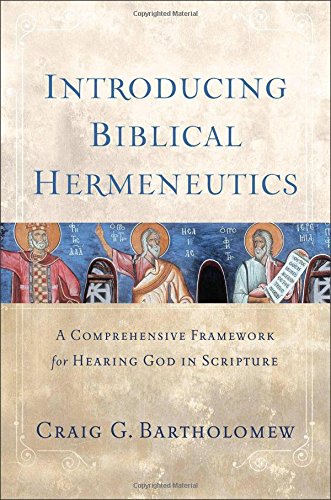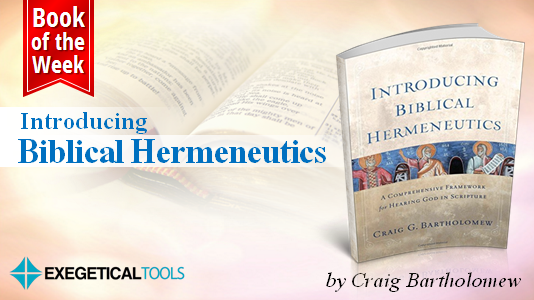There many introductions to biblical hermeneutics, but none have truly inspired me in the many ways Craig Bartholomew’s has. His Introducing Biblical Hermeneutics is truly a tour de force of the many methodologies, historical precedents, and disciplines that are wrapped up in the process of interpreting the Bible.
This book has inspired me in at least two ways. First, I’ve never seen another hermeneutics textbook that includes a chapter on lectio divina and the necessity of listening to Scripture, as Bartholomew does in ch. 2. I was inspired to slow down and put this ancient tradition into practice more often.
Second, Bartholomew agrees with the likes of Wright’s New Testament and the People of God and Köstenberger’s Invitation to Biblical Interpretation to push forcefully the idea that biblical scholars must engage with philosophy, historiography, and literary theories. Having studied much from these three areas, I wholeheartedly agree with all three scholars that we must engage this triad of disciplines. But Bartholomew has an uncanny ability to cut to the heart of these disciplines, to summarize their movements, and to extract what is useful for our hermeneutical methods (see chs. 9-11).
Aside from being inspired, Bartholomew has also provided a one-stop-shop for an entry into hermeneutical theory. But he does so from a unique perspective that biblical theologians will be much please with! Chapters 4, for example, summarizes the old Biblical Theology Movement, the responses by Barr and Childs, and the subsequent biblical theology movement that is currently ongoing.
Additionally, chapter 6 covers early and medieval Jewish biblical interpretation. This chapter alone would be useful in NT introductory courses, but he also explains how to integrate the study of Jewish traditions into our hermeneutical method. Bartholomew summarizes the important Jewish texts, explains the rise of Jewish sects, discusses the rabbis, and explains various Jewish exegetical methods. Such a chapter is unique among hermeneutics textbooks.
While on the topic of unique features, note also that Bartholomew includes a chapter on Scripture and the University. He uses the image (with a literal image on p. 475) of a tree to represent an “ecology of Christian scholarship.” Faith stands at the root, which uses Scripture to build everything on top of it. This starts with biblical theology, which then generates a Christian worldview, upon which come the branches of Christian philosophy and theology. From these two disciplines flower the rest of the tree, which includes chemistry, economics, history, psychology, political science, and all the rest. I sincerely appreciate the attempt in a hermeneutics textbook to show how proper biblical interpretation can bloom into a fully biblical and Christian approach to every field of knowledge.
A final impressive aspect of this work is that the last section, chs. 14-15, includes the following: (1) a 35 page interpretation of Hebrews, displaying the full arsenal of tools given throughout the textbook, including practical instructions on lectio divina; (2) homiletical discussion, including a history of preaching, help on application, and the centrality of Jesus. The chapter on Hebrews is a laudable example of exegesis, theology, and integration of disciplines, while the homiletical chapter is a delightful dialogue with the likes of Barth, Bonhoeffer, Hodge, Broadus, Lloyd-Jones, and Stott.
What is this book useful for?
This book is not for everyone, and it would not work for just any hermeneutics class. I cannot praise this book enough, but here are my recommendations for use:
- Intermediate textbook for personal use to gain a solid grasp of tools needed to interpret the Bible today.
- Textbook in a ThM or PhD level seminar on hermenetuics. Chapters could be selected to generate profitable discussion. I believe this textbook could be used successfully in a masters program if it is an academically rigorous program (I would have loved for this to have been my textbook in my MDiv).
- Researchers should take Bartholomew as an example of the modern day Renaissance Man. He has set a high bar for interdisciplinary work and the integration of multiple tools into his hermeneutical arsenal.
- Anyone who wants profitable discussions on the following topics: lectio divina (40-42); rule of faith (57-61); the use of “story” (63-82); biblical theology movement (90-97); the most recent Germany biblical theology (106-110); Patristic exegetical methods (126-157); Jewish sources and interpretation (ch. 6); interpretation of Hebrews (ch. 14); preaching (ch. 15); and I could go on.
You can find more information about Bartholomew’s philosophy of history that he utilizes in this volume at our post here, which summarizes his 2015 IBR address.
You can preview or buy Introducing Biblical Hermeneutics here.




One comment